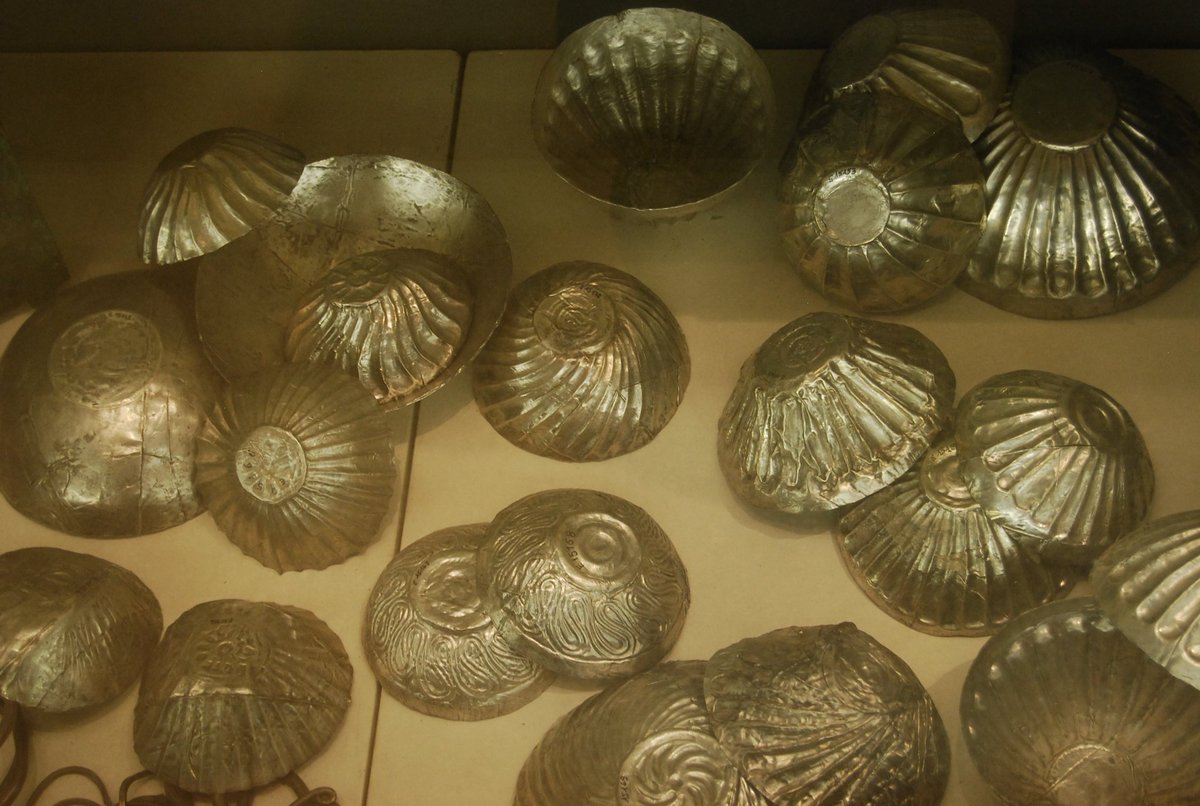This superb dagger is a crossroad of civilizations. Found in Egyptian tomb's coffin of Princess Ita, daughter of Amenemhat II 1914-1879 BC
Bronze blade form is Phoenician & the lapis lazuli/green feldspar patterns on gold hilt are Minoan. Crescent-shaped pommel is lapis lazuli.
Bronze blade form is Phoenician & the lapis lazuli/green feldspar patterns on gold hilt are Minoan. Crescent-shaped pommel is lapis lazuli.

The Dagger's Gold Hilt: The inlaid diagonal crosses of thin gold between disks are curvilinear squares inlaid with light brown carnelian.
From 12th Dynasty, reign of Pharaoh Amenemhat II, c. 1914-1879 BC-at Egyptian Museum, Cairo [1]
From 12th Dynasty, reign of Pharaoh Amenemhat II, c. 1914-1879 BC-at Egyptian Museum, Cairo [1]
It has been suggested that this dagger was imported from Byblos in Phoenicia or from Crete, or was manufactured in Egypt by a foreign craftsman at the royal court. [2]
The next posts are pieces related to the [above dagger's manufacture & origin ] 12th Dynasty reign of Pharaoh Amenemhat II 1914-1879 BC and his possible contacts with Middle East & Aegean civilizations as possible maritime commerce or tribute/taxes exerted by the Pharaoh [3]
These are part of Tod Treasure where Pharaoh Amenemhat II name was inscribed: silver cups w/ spiral decorations c. 1956-1786 BC. Perhaps of Minoan origin or Minoan art imitation from Syria. Perhaps evidence of maritime exchanges or tributes exerted from Middle East & Aegean. 

Tod Treasure of Pharaoh Amenemhat II whose name is inscribed on copper chests,treasure was a gift to the god Monthu, "sacrificed" forever, intended to remain buried. Falcon-god of war Monthu, lord of foreign lands, who received tributes/taxes or commercial & diplomatic exchanges 

Tod Treasure of Pharaoh Amenemhat II c. 1914-1879 BC was found in the foundations of the Temple at Tod (in Upper Egypt) containing lapis lazuli & 153 (mostly silver) vessels. Treasure's above photos are at the Louvre, however the other part of the treasure is in Cairo [1]
P.S. The magnificent dagger at the beginning of this thread was found in the tomb's coffin of Princess Ita, which was next to the now collapsed black pyramid [sand & limestone] of his father Pharaoh Amenemhat II at the royal necropolis of Dahshur, south of Cairo. 

Minoan gold cup [1850-1550 BC] decorated on the interior in relief with four stamped running spirals & a central rosette, here you can see the similarities with the Tod Treasure of Pharaoh Amenemhat II silver vessels Minoan spirals decorations [1956-1786 BC]. 

This Minoan gold cup is at the British Museum [1]
To finish the crossroad of civilizations point, we can't forget that the coveted lapis lazuli stone in Egyptian Art came from the mines of Badakhshan in Afghanistan.
Gold Bracelet of Ramesses II [reign. c.1279-1213 BC] decorated with a double-headed duck in lapis lazuli body.
Gold Bracelet of Ramesses II [reign. c.1279-1213 BC] decorated with a double-headed duck in lapis lazuli body.

The Minoans like the Egyptians also coveted the lapis lazuli stone, imported from the mines of Badakhshan in Afghanistan. This precious stone is the ultimate crossroad of civilizations.
Minoan gold ring shaped as a reef- knot inlaid with lapis lazuli ca. 1850-1550 BC.
Minoan gold ring shaped as a reef- knot inlaid with lapis lazuli ca. 1850-1550 BC.

The gold Bracelet of Ramesses II is at the Egyptian Museum, Cairo.
The Minoan gold ring is part of the Aegina treasure-at the British Museum, London [1]
The Minoan gold ring is part of the Aegina treasure-at the British Museum, London [1]
Fascinating scene as evidence of contact b/t Egyptian & Minoan civilizations, depicted in the Tomb of Rekhmire, Thebes ca. 1479-1425 BC.
Cretans/Minoans called Kefti
[Keftiu/Crete] by the Egyptians bring gifts [ingots of metal/metal vessels] to Rekhmire, Governor of Thebes.
Cretans/Minoans called Kefti
[Keftiu/Crete] by the Egyptians bring gifts [ingots of metal/metal vessels] to Rekhmire, Governor of Thebes.

The above facsimile painting copies a detail from a scene depicting Cretans bringing gifts in the tomb of Rekhmire at Thebes, painted at Qurna by Nina de Garis Davies for the Graphic Section of the Museum's Egyptian Expedition, 1923-1924. [1]
Rekhmire, ancient Egyptian noble & official of the 18th dynasty who served as "Governor of the Town" (Thebes) & Vizier during the reigns of Thutmosis III and Amenhotep II. The vizier's main functions were in the fields of the judiciary, treasury, war etc.. [2]
• • •
Missing some Tweet in this thread? You can try to
force a refresh

















